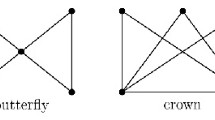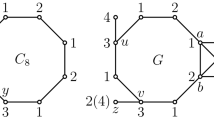Abstract
It is well-known that the graphs not containing a given graph H as a subgraph have bounded chromatic number if and only if H is acyclic. Here we consider ordered graphs, i.e., graphs with a linear ordering ≺ on their vertex set, and the function
where Forb≺(H) denotes the set of all ordered graphs that do not contain a copy of H.
If H contains a cycle, then as in the case of unordered graphs, f≺(H)=∞. However, in contrast to the unordered graphs, we describe an infinite family of ordered forests H with f≺(H) =∞. An ordered graph is crossing if there are two edges uv and u′v′ with u ≺ u′ ≺ v ≺ v′. For connected crossing ordered graphs H we reduce the problem of determining whether f≺(H) ≠∞ to a family of so-called monotonically alternating trees. For non-crossing H we prove that f≺(H) ≠∞ if and only if H is acyclic and does not contain a copy of any of the five special ordered forests on four or five vertices, which we call bonnets. For such forests H, we show that f≺(H)⩽2|V(H)| and that f≺(H)⩽2|V (H)|−3 if H is connected.
Similar content being viewed by others
References
L. Addario-Berry, F. Havet, C. L. Sales, B. Reed and S. Thomassé: Oriented trees in digraphs, Discrete Math. 313 (2006), 967–974, 2013.
M. Balko, J. Cibulka, K. Král and J. Kynčl: Ramsey numbers of ordered graphs, Electronic Notes in Discrete Mathematics, 49:419–424, 2015. The Eighth European Conference on Combinatorics, Graph Theory and Applications, EuroComb 2015.
P. Brass, G. Károlyi and P. Valtr: A Turán-type extremal theory of convex geometric graphs, In Discrete and computational geometry, volume 25 of Algorithms Combin., pages 275–300. Springer, Berlin, 2003.
S. A. Burr: Subtrees of directed graphs and hypergraphs, in: Proceedings of the Eleventh Southeastern Conference on Combinatorics, Graph Theory and Computing (Florida Atlantic Univ., Boca Raton, Fla., 1980), Vol. I, volume 28 of Congr. Numer., 227–239, 1980.
V. Capoyleas and J. Pach: A Turán-type theorem on chords of a convex polygon, J. Combin. Theory Ser. B 56 (2006), 9–15, 1992.
V. Chvátal: Perfectly ordered graphs, in: Topics on perfect graphs, volume 88 of North-Holland Math. Stud., pages 63–65. North-Holland, Amsterdam, 1984.
D. Conlon, J. Fox, C. Lee and B. Sudakov: Ordered Ramsey numbers, J. Combin. Theory Ser. B. 122 (2017), 353–383.
P. Damaschke: Forbidden ordered subgraphs, in: Topics in combinatorics and graph theory (Oberwolfach, 1990), 219–229. Physica, Heidelberg, 1990.
B. Descartes: A three colour problem, Eureka 21, 1947.
V. Dujmovic and D. R. Wood: On linear layouts of graphs, Discrete Math. Theor. Comput. Sci. 6 (2006), 339–358, 2004.
P. Erdős: Graph theory and probability, Canad. J. Math. 11 (1959), 34–38.
Z. Füredi and P. Hajnal: Davenport-Schinzel theory of matrices. Discrete Math. 103 (2006), 233–251, 1992.
M. Ginn: Forbidden ordered subgraph vs. forbidden subgraph characterizations of graph classes, J. Graph Theory 30 (2006), 71–76, 1999.
M. Klazar: Extremal problems for ordered (hyper) graphs: applications of Davenport-Schinzel sequences, European J. Combin. 25 (2006), 125–140, 2004.
M. Klazar: Extremal problems for ordered hypergraphs: small patterns and some enumeration, Discrete Appl. Math. 143 (2006), 144–154, 2004.
A. Marcus and G. Tardos: Excluded permutation matrices and the Stanley-Wilf conjecture, J. Combin. Theory Ser. A 107 (2006), 153–160, 2004.
J. Pach and G. Tardos: Forbidden paths and cycles in ordered graphs and matrices, Israel J. Math. 155 (2006), 359–380.
G. Tardos: On 0–1 matrices and small excluded submatrices, J. Combin. Theory Ser. A 111 (2006), 266–288, 2005.
C. Weidert: Extremal problems in ordered graphs, Master’s thesis, Simon Fraser University, 2009. arXiv:0907.2479.
D. B. West: Introduction to graph theory, Prentice Hall, Inc., Upper Saddle River, NJ, 1996.
Author information
Authors and Affiliations
Corresponding author
Rights and permissions
About this article
Cite this article
Axenovich, M., Rollin, J. & Ueckerdt, T. Chromatic Number of Ordered Graphs with Forbidden Ordered Subgraphs. Combinatorica 38, 1021–1043 (2018). https://doi.org/10.1007/s00493-017-3593-0
Received:
Published:
Issue Date:
DOI: https://doi.org/10.1007/s00493-017-3593-0




